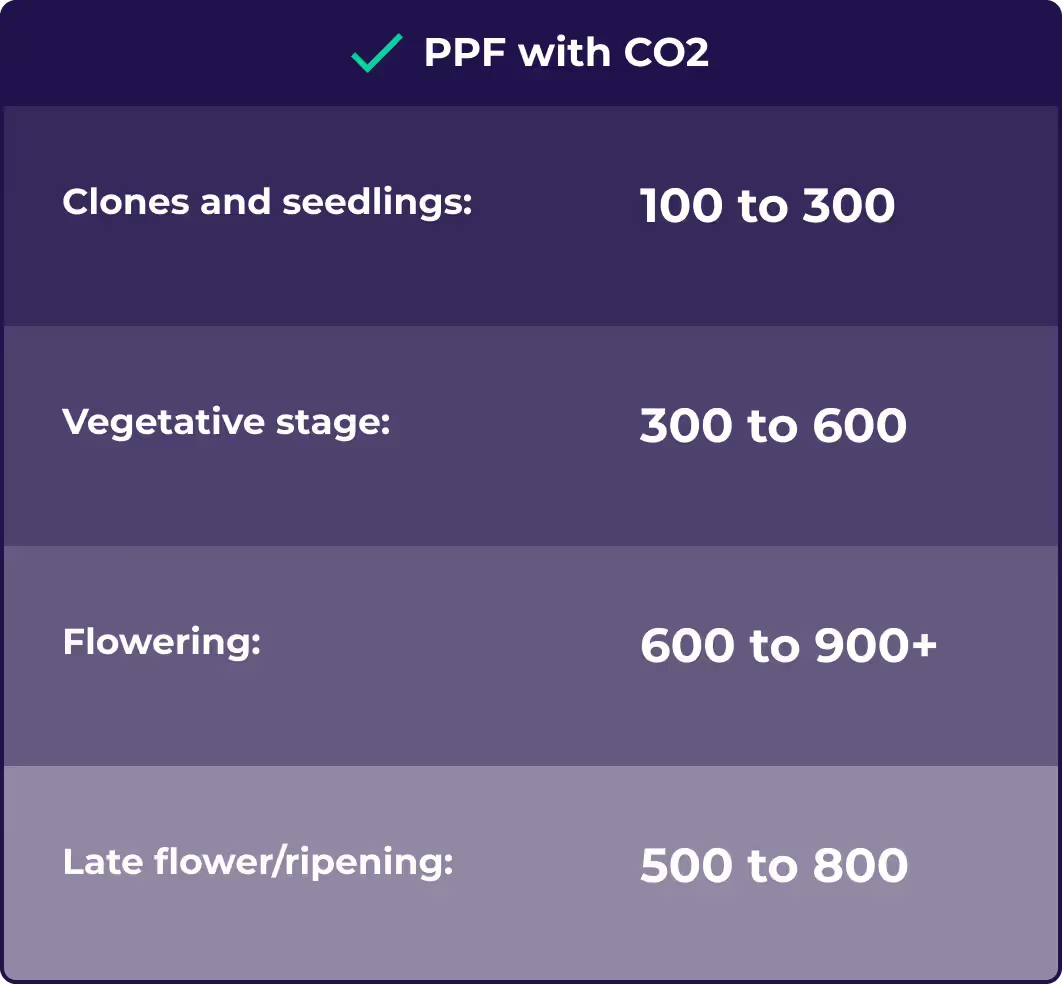The optimal PPFD for veg: Your ultimate guide


When growing indoors, we quickly discover that light is the cornerstone of cannabis cultivation.
PPFD, short for Photosynthetic Photon Flux Density, might sound like a mouthful. But it's simply a measure of light intensity that fuels photosynthesis, which is essential for plants to thrive.
Following on from What’s the best PPFD for seedlings, this guide will help you to understand the ideal PPFD levels for the vegetative stage, a critical period for establishing robust, vigorous plants.
In the process of growing cannabis and fine-tuning your plants’ growth, mastering PPFD is a transformative step.
We're here to shine a light on the science behind PPFD and offer practical advice, empowering you to adjust your grow lights perfectly and watch your plants flourish under the ideal conditions.
Disclaimer: Any information given on this site is for educational purposes only. Please ensure if you’re growing cannabis, you’re doing so in accordance with the law and subject to appropriate permissions and licenses of the applicable country.
Understanding PPFD
What is PPFD (photosynthetic photon flux density)?
PPFD measures the amount of light in photons that reach a square meter of your plant's canopy per second.
Think of it as the portion of the light spectrum that plants in your grow room can actually use for photosynthesis.
PPFD's impact on each different growth stage
PPFD heavily influences the journey of a plant through every growth stage. During the vegetative stage, plants undergo explosive growth. They develop their root systems and expand their foliage, and PPFD plays a crucial role.
When your indoor plants have the right intensity and quality of light, this sets the stage for robust growth, preparing plants for the following flowering stage.

Tailoring PPFD to your plants’ specific stage of growth
Different stages of growing require different PPFD levels. Seedlings and young plants need gentle light, mimicking the soft sunlight of spring.
As they enter the vegetative stage, they crave more intensity, similar to summer's bright, direct light.
This section will guide you through adjusting PPFD to meet the changing needs of your indoor plants, ensuring they receive the optimal light at every growth stage.
How much PPFD for veg?
The desired PPFD for veg
Uncovering how much PPFD you need during the vegetative stage is crucial for nurturing strong and healthy plants.
Light-hungry plants, like cannabis, flourish under PPFD values from 300-600 μmol/m²/s during their vegetative phase.
It's all about understanding the specific needs of your plants and adjusting the intensity of the light provided accordingly.
How much PPFD for early veg vs. full veg
In the early vegetative stage, plants are still tender and adapting to their environment, requiring a gentler PPFD level, around 200-400 μmol/m²/s, to avoid stress and light burn.
As they grow sturdier and enter the full vegetative phase, they can handle more intense light, necessitating increased PPFD. This gradual adjustment supports optimal growth and prepares plants for the even higher light demands of the flowering stage.

The Ideal PPFD range different growth stages
How much PPFD for the seedling stage
When growing cannabis, during the delicate seedling stage, plants require a gentle introduction to light. The ideal PPFD level for seedlings is between 100-300 micromoles per square meter per second (μmol/m²/s).
This softer lighting mimics the diffused sunlight of early spring, providing enough energy for seedling stage plants to develop their initial leaves without overwhelming them.
How much PPFD for early vegetative stage:
As indoor plants transition into the early vegetative stage, their capacity to absorb light increases. The ideal PPFD for veg is 200-400 μmol/m²/s because it supports healthy leaf growth.
This moderate light level encourages plants to develop a strong vegetative structure, setting a robust foundation for the vegetative and flowering stages.
How much PPFD for full vegetative stage:
In the full vegetative stage, plants are ready to maximise their photosynthesis for maximum growth. The optimal PPFD levels increase to 400-600 μmol/m²/s.
This range promotes vigorous growth, preparing the plant for flowering. It's important to monitor plants for any signs of stress and adjust your lights’ intensity as needed.
Optimising PPFD for vegetative growth
When aiming for ideal PPFD levels during the vegetative stage, it's crucial to consider various factors, including the spectrum of light emitted by your chosen artificial light source.
Full spectrum lighting, such as LED lights, provide a balanced mix of red light, blue light, and other wavelengths essential for healthy growth.
Adjusting these wavelengths effects plant growth in different ways. With more blue light, the plants will stay short and bushy. More red light in the spectrum will cause plants to stretch.

How much light for the flowering stage:
The flowering stage demands even more light, with ideal PPFD levels ranging from 600-900 μmol/m²/s. This increase in light intensity supports the development of buds and flowers, driving the reproductive phase.
Plants in the veg and flowering stage may benefit from PPFD values at the upper end of this range, provided that other environmental conditions, such as temperature and CO2 levels, are also optimised.

Late flowering to harvest:
During the late flowering stage leading up to harvest, maintaining high PPFD levels is crucial for the maturation of fruits and flowers. However, observing flowering plants for any signs of stress is essential. Excessive intensity can damage the delicate flowers and affect the yield quality.
Adjusting light intensity:
Throughout the different growth stages, adjusting the intensity and duration of light is key to meeting the plant's changing needs.
A dimmable LED grow light system can provide the flexibility to fine-tune PPFD levels, ensuring optimal light conditions from seedling to harvest.
Additionally, understanding the daily light integral (DLI) can help gauge the total amount of light plants receive daily, allowing you to fine-tune your light cycle and further optimise growth conditions.
By tailoring PPFD levels to each growth phase, you can support your plants through the entire lifecycle, promoting healthy development and maximising yields.
Measuring PPFD in your grow space
To ensure your cannabis plants thrive, accurately measuring light intensity in your grow space is crucial.
A PAR (Photosynthetic Active Radiation) meter is essential for this task, as it quantifies the light within the spectrum that plants utilise for photosynthesis.
By providing insights into the PPFD (Photosynthetic Photon Flux Density) your plants receive, a PAR meter offers a clear understanding of their light exposure

Are PPFD and PAR different?
While related, PPFD and PAR are distinctly different concepts in plant lighting.
- PAR refers to the range of light wavelengths (typically 400 to 700 nanometers) that plants use for photosynthesis.
- PPFD, on the other hand, measures the actual amount of PAR reaching the cannabis plant surface per second, expressed in micromoles of photons per square meter per second (μmol/m²/s).
While PAR describes the type of light plants need, PPFD quantifies how much light reaches the plant, making both parameters essential for optimising growth conditions.
How to use PAR and PPFD meters to optimise your grow space
Measure at canopy level:
Use a light meter to take readings. Position the sensor at the same height as your vegging plants to accurately assess their light exposure.
Continuous data collection provided by the Grow Sensor’s top-mounted PPF meter and PPFD sensor facilitates thorough analysis through user-friendly graphs.

Verify uniformity:
Assess light distribution across the canopy by moving the photosynthetic active radiation (PAR) meter throughout the growing area. Consistent PPFD levels across the entire space are crucial for uniform growth.
Make lighting adjustments:
Based on your measurements, adjust the height or intensity of your lighting system to achieve the recommended PPFD range for veg (300-600μmol/m²/s).
Ensuring uniform PPFD distribution prevents uneven growth and encourages plants to grow healthily. Regular monitoring and adjustments contribute significantly to optimal seedling growth and development.

Can you have too much light?
Yes. While achieving the right PPFD levels is crucial for the vegetative stage, you can have too much of a good thing.
Excessive PPFD can lead to light stress, a condition that hinders healthy growth and can cause severe damage. Symptoms include bleached or yellowing leaves, slow growth, and, in severe cases, burn damage.
Preventing light burn in sensitive plants
Young plants and certain species are particularly sensitive to high light intensities. Light burn is a common issue where leaves closest to the light source may become discoloured or crisp, severely affecting the plant's overall health.
It’s crucial to monitor the appearance of your plants and watch for any early signs of light stress or burn. You’ll need to provide less light and slightly lower PPFD levels as soon as you see any signs.
Measuring and adjusting PPFD for veg stage success
Fine-tuning your grow setup after taking PPFD readings in your space is essential for maintaining optimal light conditions for vegetative stage plants. Here's a concise guide on effective PPFD adjustments:
Vary light height:
Altering the distance between your grow lights and the plant canopy can raise or lower PPFD levels. Lowering lights increases PPFD while raising them decreases it. Take care to manage heat from lights to prevent plant overheating.
Change up your light intensity:
If your grow lights offer adjustable intensity settings, use them to achieve desired PPFD levels without relocating the lights.
Use reflective materials:
Enhance light distribution by placing reflective materials around your growing space. This strategy helps boost PPFD in areas with lower light exposure, ensuring more uniform growth.
Impose light schedules:
Maintain a consistent, typically providing 18 hours of light followed by 6 hours of darkness. This regimen supports healthy vegative growth while allowing for essential rest and respiration periods.

Achieving Optimal PPFD for Cannabis Growth
Ensuring cannabis plants receive enough light during the vegetative stage is paramount for healthy development. Monitoring light intensity using light meters and assessing PPFD output helps gauge whether plants receive adequate light energy.
Understanding daily light integral (DLI) and measuring the intensity of light in your growing space allows you to fine-tune your lighting setups to match the photoperiod of your cannabis plants.
By optimising light levels, you can provide the ideal conditions for robust vegetative growth, leading to successful cultivation outcomes.
Regular monitoring and adjustment are paramount as plants grow, with their PPFD requirements evolving accordingly. Observing plant health and your plant’s growth patterns informs necessary modifications to ensure optimal light exposure at all times.
Case studies: PPFD for cannabis in veg
A study focused on cannabis cultivation explored how various PPFD levels influenced plant growth, yield, and quality. The research demonstrated that cannabis plants have a high capacity for photosynthesis and that yield and quality can be significantly impacted by the PPFD levels.
The study used a range of PPFD from 120 to 1,800 μmol·m−2·s−1, showing the nuanced relationship between light’s intensity, plant growth stage, and overall plant performance. It underscored the importance of selecting the optimum PPFD for maximising yields while minimising energy consumption.
Another study around cannabis cultivation investigated the effects of different PPFD levels on indoor-grown cannabis, specifically examining the impact on yield and cannabinoid content.
The research employed PPFDs of 600, 800, and 1,000 μmol·m−2·s−1, highlighting how yield increased proportionally with light intensity, although ultraviolet radiation did not affect the yield or cannabinoid content.
This finding is particularly relevant for growers looking to optimise their lighting setups for maximum efficiency and yield.
These studies collectively underline the critical role of PPFD in plant growth during the vegetative stage.
They demonstrate that while higher PPFD levels can enhance successful growth and yield, a nuanced balance must be struck to ensure energy use is optimised and plant health is not compromised.
The advantages of using a Grow Sensor
A Grow Sensor can transform how you cultivate plants, offering a competitive edge for serious growers. It provides instant access to vital information about the conditions within your grow space.
Stay informed about key environmental variables such as PPFD, humidity, temperature, and CO2 concentration.
This invaluable data empowers you to adjust your growing practices to ensure your plants receive the precise light levels needed throughout their lifecycle.
This careful management promotes optimal health and can significantly increase yields from the initial seedling phase to the flowering period.
Here's a breakdown of some more of the Grow Sensor’s capabilities:
- Vapour Pressure Deficit (VPD) tracking.
- Calculation of Daily Light Integral (DLI) to gauge light exposure over time.
- Leaf Surface Temperature (LST) sensing for assessing plant health.
- Dew point monitoring to prevent humidity-related issues.
- Compatibility with the Grow soil probe for measuring EC, soil moisture, dry backs, and root zone temperature.
- Provision of essential data for crop steering techniques to maximise yields.
- Offline data logging capability for convenient crop registration.
The Grow Sensor allows you to fine-tune your growing environment precisely, resulting in healthier plants and more abundant harvests.

Takeaways
In our quest for the best PPFD for veg, we've uncovered how this key measure of light intensity is critical for nurturing vigorous, healthy plants.
From understanding the basics of PPFD and PPFD requirements to adjusting PPFD levels, each step is pivotal in ensuring your plants receive the optimal light they need to flourish.
Achieving the perfect PPFD levels for your indoor grow is both an art and a science. It requires a blend of knowledge, observation, and adjustment.
Remember, the goal is not just to meet the basic light requirements of your plants but to create an environment where they can reach their full potential.
With this guide's insights and strategies, you can fine-tune your lighting setup, ensuring your plants enjoy the ideal conditions for robust growth.
Every grow room is unique, and what works for one may not work for another. Therefore, we encourage you to use this guide to experiment with PPFD levels to find what best suits your specific plants and setup.
Observe your plants' responses, make adjustments as needed, and don't hesitate to revisit different sections of this guide for guidance.
With patience and careful attention, you'll see your plants thrive under the glow of your grow lights, leading to a successful and rewarding indoor gardening experience.
Happy growing!











.avif)








